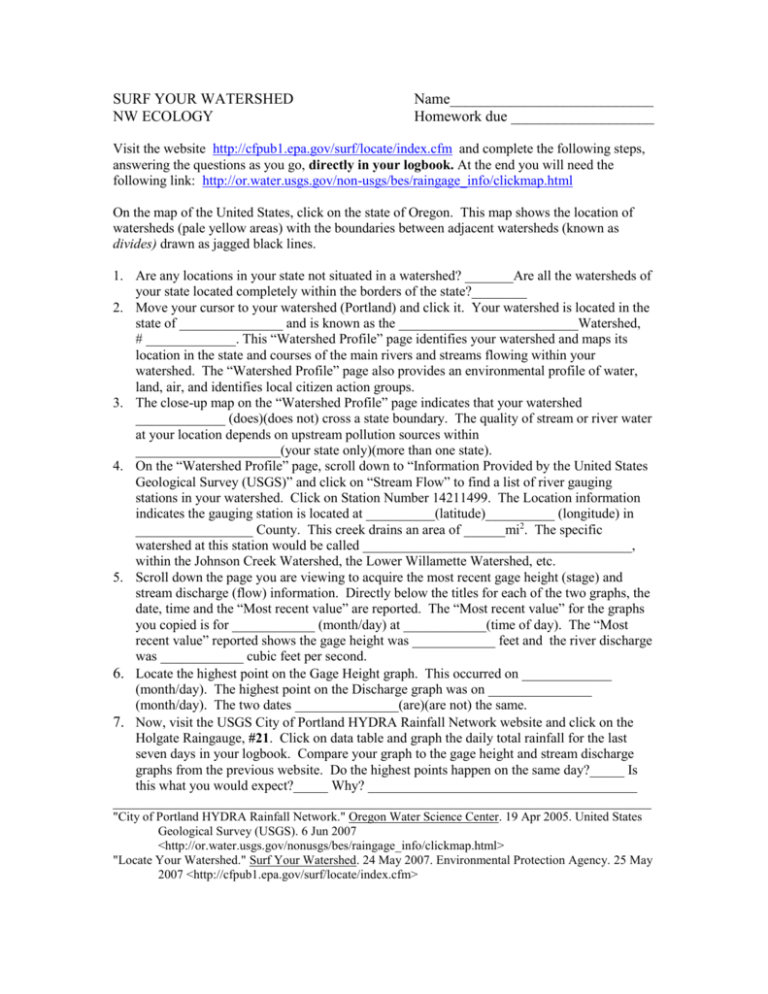SURF YOUR WATERSHED
advertisement

SURF YOUR WATERSHED NW ECOLOGY Name___________________________ Homework due ___________________ Visit the website http://cfpub1.epa.gov/surf/locate/index.cfm and complete the following steps, answering the questions as you go, directly in your logbook. At the end you will need the following link: http://or.water.usgs.gov/non-usgs/bes/raingage_info/clickmap.html On the map of the United States, click on the state of Oregon. This map shows the location of watersheds (pale yellow areas) with the boundaries between adjacent watersheds (known as divides) drawn as jagged black lines. 1. Are any locations in your state not situated in a watershed? _______Are all the watersheds of your state located completely within the borders of the state?________ 2. Move your cursor to your watershed (Portland) and click it. Your watershed is located in the state of _______________ and is known as the __________________________Watershed, # _____________. This “Watershed Profile” page identifies your watershed and maps its location in the state and courses of the main rivers and streams flowing within your watershed. The “Watershed Profile” page also provides an environmental profile of water, land, air, and identifies local citizen action groups. 3. The close-up map on the “Watershed Profile” page indicates that your watershed _____________ (does)(does not) cross a state boundary. The quality of stream or river water at your location depends on upstream pollution sources within _____________________(your state only)(more than one state). 4. On the “Watershed Profile” page, scroll down to “Information Provided by the United States Geological Survey (USGS)” and click on “Stream Flow” to find a list of river gauging stations in your watershed. Click on Station Number 14211499. The Location information indicates the gauging station is located at __________(latitude)__________ (longitude) in _________________ County. This creek drains an area of ______mi2. The specific watershed at this station would be called _______________________________________, within the Johnson Creek Watershed, the Lower Willamette Watershed, etc. 5. Scroll down the page you are viewing to acquire the most recent gage height (stage) and stream discharge (flow) information. Directly below the titles for each of the two graphs, the date, time and the “Most recent value” are reported. The “Most recent value” for the graphs you copied is for ____________ (month/day) at ____________(time of day). The “Most recent value” reported shows the gage height was ____________ feet and the river discharge was ____________ cubic feet per second. 6. Locate the highest point on the Gage Height graph. This occurred on _____________ (month/day). The highest point on the Discharge graph was on _______________ (month/day). The two dates _______________(are)(are not) the same. 7. Now, visit the USGS City of Portland HYDRA Rainfall Network website and click on the Holgate Raingauge, #21. Click on data table and graph the daily total rainfall for the last seven days in your logbook. Compare your graph to the gage height and stream discharge graphs from the previous website. Do the highest points happen on the same day?_____ Is this what you would expect?_____ Why? _______________________________________ ______________________________________________________________________________ "City of Portland HYDRA Rainfall Network." Oregon Water Science Center. 19 Apr 2005. United States Geological Survey (USGS). 6 Jun 2007 <http://or.water.usgs.gov/nonusgs/bes/raingage_info/clickmap.html> "Locate Your Watershed." Surf Your Watershed. 24 May 2007. Environmental Protection Agency. 25 May 2007 <http://cfpub1.epa.gov/surf/locate/index.cfm>






